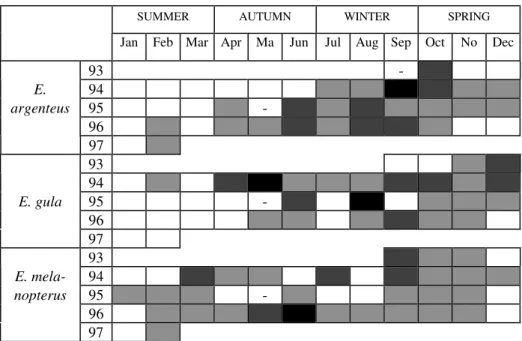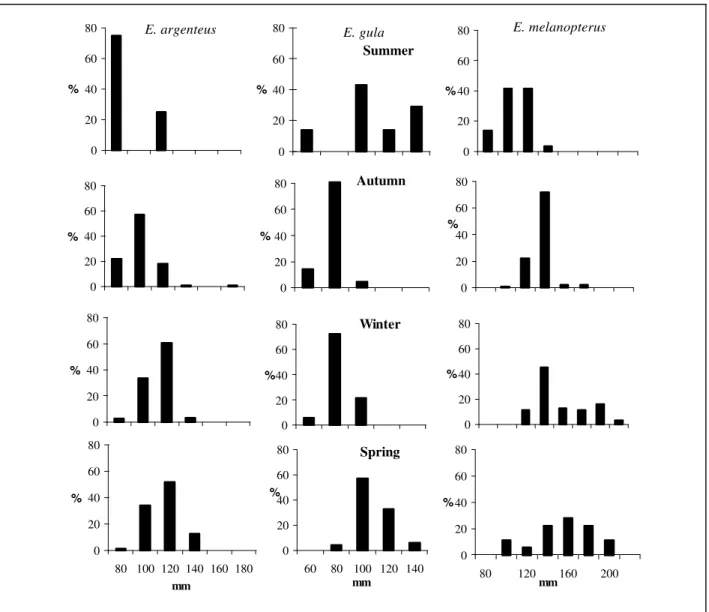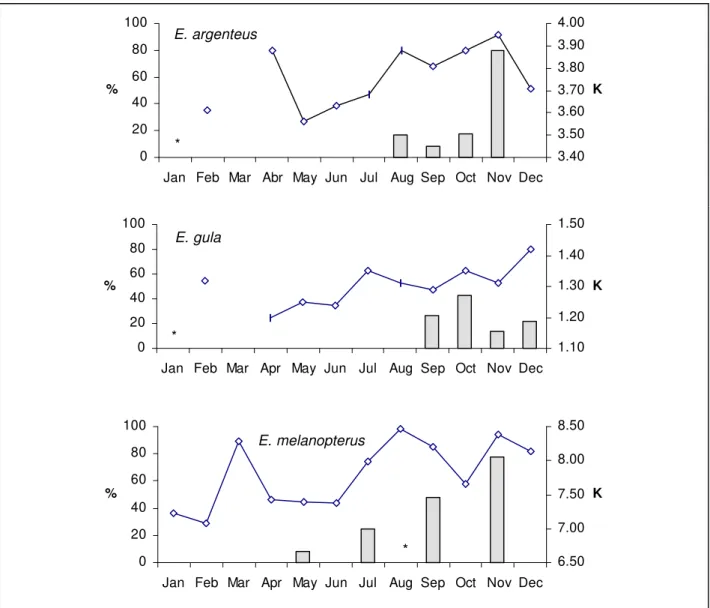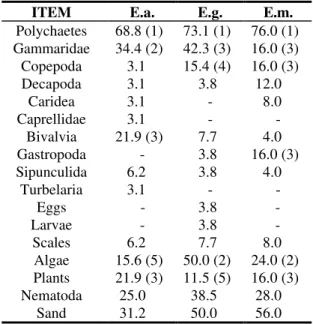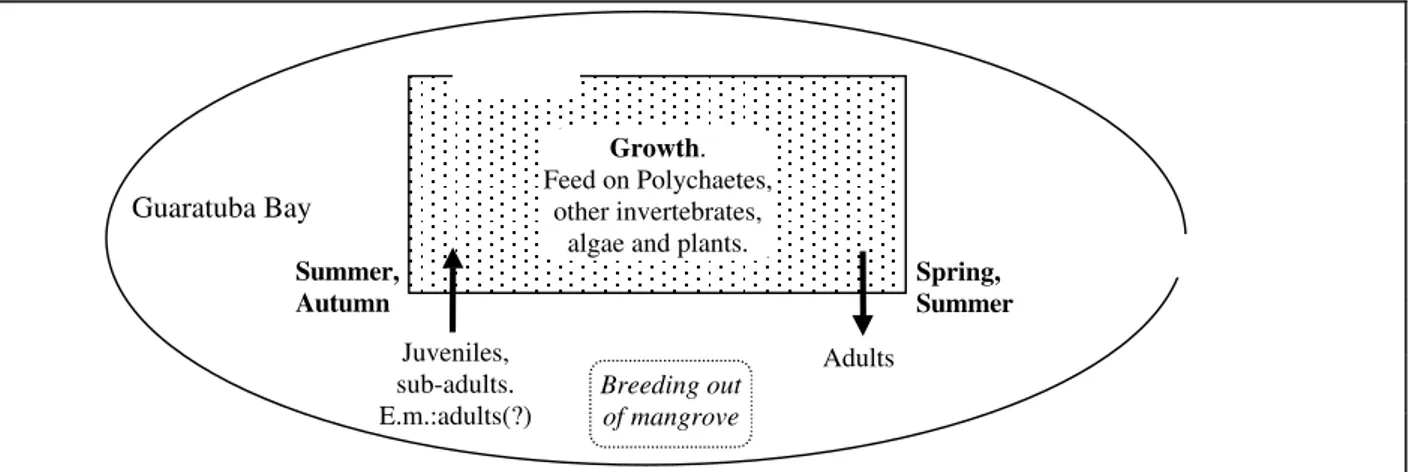The Mangrove as a Temporary Habitat for Fish: the
Eucinostomus
Species at Guaratuba Bay, Brazil
(25
º
52'S;48
º
39'W).
Paulo de Tarso C. Chaves* and Gislaine Otto
Departamento de Zoologia, Universidade Federal do Paraná. C.P. 19020, 81531-990, Curitiba, Brasil
ABSTRACT
Several coastal fish use the estuarine habitat during a part of their life cycle. These sites are considered good for the reproductive activity, as well as for the growth of larvae and juveniles. Concerning the Gerreidae, however, many studies reveal that most species leave the estuaries to reproduce at sea. At Guaratuba Bay, southern Brazil, this family is represented by three genera and five species, which make an important fraction of the local assemblage. The present study investigated the populational structure and breeding habits of three Eucinostomus species, in order to know what relationship exists between them and the mangrove. It was found that the Guaratuba mangrove represents a transitory habitat for the life cycle of the Eucinostomus species. The sub-adults grow in the mangrove throughout the year and leave this milieu in spring or summer, when they complete the gonadal maturation and presumably spawn. E. argenteus and E. gula do not return to the mangrove after spawning. The three species feed mainly on polychaetes, but differences occur with respect to the secondary components of the diet.
Key-words: Fish, Gerreidae, Estuaries, Mangrove.
* Author for correspondence.
INTRODUCTION
It is usually assumed that the estuarine habitats constitute a satisfactory site for the protection and growth of coastal fish species (Thayer et al., 1987; Sasekumar et al., 1992). Nevertheless, seasonal oscillations in the physicochemical parameters in this type of environment, that are a consequence of the strong, unstable continental influence, could be a selective factor for the permanency or not of the populations in an estuary throughout their life cycle. The inside/outside movements to/from the estuaries are a strategy adopted by many fish species, in order to utilize this milieu only when its conditions are satisfactory (Amanieu & Lasserre, 1982). These temporary, migratory species form an important part of the estuarine fish assemblages.
present different patterns in relation to the milieu. In eastern Atlantic, for example, E. melanopterus inhabits the estuaries of Ivory Coast only during the juvenile phase, while Gerres nigris inhabits it permanently (Albaret & Desfossez, 1988). The objective of the present study was to know the biological attributes of the Eucinostomus populations at the Guaratuba Bay, in order to evaluate if they utilize this milieu permanently or only during a certain period of their life cycle.
MATERIALS AND METHODS
Samples were taken monthly from September 1993 through February 1997 (except May 1995) in random points of the mangrove at Guaratuba Bay, southern Brazil (25º52'S;48º39'W). A
map showing this area is available in Chaves (1995) and Chaves & Vendel (1997a,b). Fish were caught using an otter trawl with a 20mm mesh. The total number of specimens collected was 355 for E. argenteus, 191 for E. gula and 195 for E. melanopterus. The data of abundance are presented as number of individuals captured per unit of effort. Repeated Measures Analysis of Variance was used to examine the change in fish abundance over time.
After being removed to the laboratory under freezing conditions, the specimens were measured (total length, TL) and frequently weighted (W). Gonads from 213 individuals of E. argenteus, 121 of E. gula and 122 of E. melanopterus were examined in order to know the sex and to evaluate a possible spawning activity. For this, we adopted the visual attributes presented by Vazzoler (1996), that included the differentiation between the immature, developing, ripe and post-spawning stages. In the presentation of the results, however, considering the objective of the study, the data were assembled in only two groups: the "immature" and the "non-immature", the latter consisting of the last three stages mentioned above and functioning as a signal of near spawning activity.
Individual values of the Condition Factor (K) (Vazzoler, 1996) were given by K=W/TLb, where b is the coefficient angular from weight/length relationship adjusted to each
species (300 specimens of E. argenteus, 160 of E. gula and 193 of E. melanopterus).
The stomach content of 32 individuals of E. argenteus (86mm CT 135mm), 26 of E. gula (100mm CT 136mm) and 25 of E. melanopterus (110mm CT 218mm), proceeding from all season of the year, was fixed in a 10% formaldehyde solution for a microscopical analyses. The data obtained were processed by the Frequency of Occurrence method, which is defined as a proportion of individuals that present a certain item with respect to the total number of individuals whose stomach content was examined (Zavala-Camin, 1996).
RESULTS
Monthly distribution of catch of the three Eucinostomus species along the period of study is showed in Fig. 1. ANOVA demonstrated that the three species had similar changes in abundance over time. That is, there were no significant differences in abundance among species over years or months of the year (repeated measures ANOVA, all month and year contrasts by species ρ>0.05). Because years and months were not different among species, species were grouped to examine monthly changes in abundance. Significant change in fish catch occurred over months (Wilk's lambda = 0.575, ρ<0.05). Catches were highest during the months of June and September, and these months were not significantly different only from May, August and October (Table 1).
The length of sampled specimens varied between 80 and 182mm for E. argenteus, 73 and 150mm for E. gula and 80 and 227mm for E. melanopterus (Fig. 2). In E. argenteus and E. melanopterus, the modal length classes increased from summer to spring, but in E. gula they increased from autumn to summer (Fig. 2).
The weight/length (gram and millimetre) relationship is expressed by the following equations:
W = 3.76x10-8TL3.2448 (r=0.9708) in E. argenteus;
SUMMER AUTUMN WINTER SPRING
Jan Feb Mar Apr Ma Jun Jul Aug Sep Oct No Dec
93
-E. 94
argenteus 95
-96 97 93 94
E. gula 95
-96 97 93 E. mela- 94
nopterus 95
-96 97
Fig. 1 - Relative numerical abundance of the Eucinostomus spp specimens caught at Guaratuba mangrove between September 1993 and February 1997, according to the species. Code:
n = 0 0 < n < 5% 5 n < 10% n ≥ 10%
TABLE 1 - Results of the least significant difference test to ANOVA Repeated Measures applied to compare the numerical abundance in pairs of months. 1 to 12: January to December. +: with difference; -: no difference (ρ<0.05).
1 2 3 4 5 6 7 8 9 10 11 12 1 - - - - + + - + + - - -2 - - - + - - + - - -3 - - - + - - + - - -4 - - - + - - + - - -5 + - - - -6 + + + + - - + - - - + + 7 - - - + - - + - - -8 + - - - -9 + + + + - - + - - - + + 10 - - - -11 - - - + - - + - - -12 - - - + - - + - -
-W = 7.72x10-6TL3.0723 (r=0.9823) in E. melanopterus.
The monthly average values of the Condition Factor showed an irregular variation along the time in all species (Fig. 3). The minimum mean values were registered in autumn (E. argenteus nd E. gula) or summer (E. melanopterus); the
maximum being in spring or in the middle of winter, in the same order.
Analysis of the gonads showed that the percentage of the non-immature individuals increased for all species from winter through spring, reaching the most important value in November for E. argenteus and E. melanopterus and in October for E. gula (Fig. 3). No post-spawning individuals were registered in the material examined.
Euar Sum Aut W in Spr Eugu Su Au W i Sp
80 75 80 22 80 2,6 80 1,3 60 14 60 14,3 60 5,9 60 0
100 0 100 57 100 33,3 100 34 80 0 80 80,9 80 72,5 80 4,1
120 25 120 18 120 61 120 52 100 43 100 4,8 100 21,6 100 57,1
140 0 140 1,3 140 3,1 140 13 120 14 120 0 120 0 120 32,7
160 0 160 0 160 0 160 0 140 29 140 0 140 0 140 6,1
180 0 180 1,3 180 0 180 0
Eume Su Au
80 14 80 0
100 41 100 1,2
120 41 120 22
140 3,4 140 72
160 0 160 2,3
180 0 180 2,3
200 0 200 0
220 0 220 0
W i Sp
80 0 80 0
100 0 100 11
120 11 120 5,6
140 45 140 22
160 13 160 28
180 11 180 22
200 16 200 11
220 3,2 220 0
0 20 40 60 80 % E. argenteus 0 20 40 60 80 % 0 20 40 60 80 % 0 20 40 60 80
80 100 120 140 160 180 mm % Spring 0 20 40 60 80
60 80 100 120 140
mm % Winter 0 20 40 60 80 % Autumn 0 20 40 60 80 % E. gula Summer 0 20 40 60 80 % E. melanopterus 0 20 40 60 80 % 0 20 40 60 80 % 0 20 40 60 80 % 0 20 40 60 80
80 120 160 200
mm %
Fig. 2 - Relative size class frequency of the Eucinostomus spp specimens, with respect to the total number of individuals per species caught each season.
DISCUSSION
Considering the abiotical data obtained by Chaves & Vendel (1997b) for the same period, the three Eucinostomus species are more abundant at Guaratuba mangrove when the salinity reaches the most important level (more than 15‰ from May to October, eventually 35‰). In summer, when the input of fluvial waters is most expressive (the salinity level decreases to less than 5‰), the populational density reaches its minimum value. In fact, the sensibility of Gerreidae species to salinity levels in a milieu has been mentioned in many studies. Cyrus & Blaber (1982) associated this
parameter to the distribution pattern of Gerres spp in estuaries of Natal, South Africa, and a similar pattern to that observed in Guaratuba is cited by Albaret & Desfossez (1988) for E. melanopterus at Ivory Coast: this species presents a maximal abundance when the salinity level is higher, and migrate to sea when the lagoon is under freshwater inputs.
E. argenteus
0 20 40 60 80 100
Jan Feb Mar Abr May Jun Jul Aug Sep Oct Nov Dec
%
3.40 3.50 3.60 3.70 3.80 3.90 4.00
K
*
E. gula
0 20 40 60 80 100
Jan Feb Mar Apr May Jun Jul Aug Sep Oct Nov Dec
%
1.10 1.20 1.30 1.40 1.50
K
*
E. melanopterus
0 20 40 60 80 100
Jan Feb Mar Apr May Jun Jul Aug Sep Oct Nov Dec
%
6.50 7.00 7.50 8.00 8.50
K
*
Fig. 3 - Relative frequency variation of the Non-immature individuals (%, bars) and mean values of the Condition Factor (K, polygon) according to the species. Values of K are multiplied per 106 in E. argenteus and E. melanopterus and per 105 in E. gula. (*) no individuals were analysed with respect to the stage of maturation.
coast, for example, move to mangroves only at the juvenile phase, an event considered by Thayer et al. (op. cit.) as an indicator of the protection role presented by this ecosystem. In the Eucinostomus species of Guaratuba mangrove, the increase in percentage of non-immature individuals (spring) precedes the minimum abundance of stocks (summer). Hence, it is supposed that the spawning activity occurs during summer and in the adjacent marine zone or, if internally to Guaratuba Bay, out of mangrove. Additionally, the increase in the Condition Factor values, verified from autumn to spring, can be associated to the usual
increase in both the gonadal volume and the somatic reserves at the final period of maturation (Vazzoler, 1996).
size registered for the southern Brazilian coast (Menezes & Figueiredo, 1980).
TABLE 2 - Frequence of Occurrence values (%) for the stomach contents of 32 specimens of E. argenteus (E.a.), 26 of E. gula (E.g.) and 25 of E. melanopterus (E.m.) from Guaratuba mangrove, during the study period. (1) to (5) indicate the ranking of the main alimentary items.
ITEM E.a. E.g. E.m.
Polychaetes 68.8 (1) 73.1 (1) 76.0 (1) Gammaridae 34.4 (2) 42.3 (3) 16.0 (3) Copepoda 3.1 15.4 (4) 16.0 (3)
Decapoda 3.1 3.8 12.0
Caridea 3.1 - 8.0
Caprellidae 3.1 -
-Bivalvia 21.9 (3) 7.7 4.0
Gastropoda - 3.8 16.0 (3)
Sipunculida 6.2 3.8 4.0
Turbelaria 3.1 -
-Eggs - 3.8
-Larvae - 3.8
-Scales 6.2 7.7 8.0
Algae 15.6 (5) 50.0 (2) 24.0 (2) Plants 21.9 (3) 11.5 (5) 16.0 (3)
Nematoda 25.0 38.5 28.0
Sand 31.2 50.0 56.0
Thus, after spawning, the largest individuals presumably remain at open sea or at another place in the Bay. However, for E. melanopterus, the individuals are usually found in the mangrove at a length similar to the maximum known for this species, indicating that after spawning some adults enter this area. This conclusion is also supported by the presence of E. melanopterus in the mangrove during summer, suggesting that the return movement may start immediately after the breeding activity. The absence of small individuals in samples of all species can be explained by the selectivity of the sampler instrument (mesh size and depth), as well as by the use of the marginal areas protected by roots, where the otter trawl is not operable.
It was verified that the diet of the three Eucinostomus species has the same nature with respect to the chief items consumed. The higher percentage of sand and polychaetes, as well as the nature of other items in the stomach contents, indicate that at Guaratuba these species have a benthivorous habit. A similar pattern was know for Diapterus rhombeus (Chaves & Otto, 1998). In fact, the protrusible
mouth in this family helps the feeding activity on the substrate (Albaret & Desfossez, 1988). These authors found that an African population of E. melanopterus fed mainly on Decapoda crustaceans, fish eggs and small Gastropoda, items which were also found at Guaratuba, but at a less important percentage.
Between the three Eucinostomus species from Guaratuba mangrove, a relative uniformity was observed in some biological parameters: increase in abundance, coinciding with the period of higher salinity and smaller temperature values; increase of the Condition Factor values from autumn to spring; absence of spawning in the mangrove area; and a benthivorous diet primarily based on polychaetes. In other parameters, each species presents some particularities: the secondary items composing the alimentary regime; the migratory habit including or not a return to the mangrove. We conclude that E. argenteus, E. gula and E. melanopterus inhabit the Guaratuba mangrove temporarily, but utilize this milieu to grow during an extended period of the year (Fig. 4).
RESUMO
ACKNOWLEDGEMENTS
We would like to thank Ronny de Moura (UFPR) and Sidineia Amadio (INPA) for their
suggestions on how to improve the manuscript. Dr James Hoper (CNPq/UFPR) has provided the statistical analysis. This work (number 992 of the
Fig. 4 - Diagram of movements and habits of the Eucinostomus species at the mangrove of the Guaratuba Bay. (E.m.= E. melanopterus.)
Zoology Department, UFPR) was concluded at the Continental and Marine Hydrobiology Laboratory, Montpellier II University, France. This research was supported by Conselho Nacional para o Desenvolvimento Científico e Tecnológico (CNPq) grants to the authors.
REFERENCES
Albaret, J.-J. & Desfossez, P. (1988), Biologie et écologie des Gerreidae (Pisces, Teleostei) en lagune Ébrié (Côte d’Ivoire). Rev. Hydrobiol. trop., 21, 71-88.
Amanieu, M. & Lasserre, G. (1982), Organisation et évolution des peuplements lagunaires. Oceanologica Acta (n.sp.): Proceedings International Symposium on coastal lagoons. Bordeaux, France, 8-14 September 1981, 201-213.
Chaves, P.T.C. (1995), Atividade reprodutiva de Bairdiella ronchus (Cuvier) (Pisces, Sciaenidae) na Baía de Guaratuba, Paraná, Brasil. Revta bras. Zool.,12, 759-766.
Chaves, P.T.C. (1998), Estrutura populacional de Pomadasys corvinaeformis (Steindachner) (Teleostei, Haemulidae) na Baía de Guaratuba, Paraná. Revta bras. Zool., 15, 203-209.
Chaves, P.T.C. & Otto, G. (1998), Aspectos biológicos de Diapterus rhombeus (Cuvier) (Teleostei, Gerreidae) na Baía de Guaratuba, Paraná, Brasil. Revta bras. Zool., 15, 289-295.
Chaves, P.T.C.; Rickli, A. & Bouchereau, J.-L. (1998), Stratégie d'occupation de la mangrove de la baie de Guaratuba (Brésil) par le sciaenidae prédateur Isopisthus parvipinnis (Teleostei, Pisces). Cah. Biol. Mar., Roscoff, 39, 63-71. Chaves, P.T.C. & Vendel, A.L. (1997a), Indicadores
reprodutivos das espécies de Citharichthys Bleeker (Teleostei, Pleuronectiformes) na Baía de Guaratuba, Paraná, Brasil. Revta bras. Zool., 14, 73-79.
Chaves, P.T.C. & Vendel, A.L. (1997b), Reprodução de Stellifer rastrifer (Jordan) (Teleostei, Sciaenidae) na Baía de Guaratuba, Paraná, Brasil. Revta bras. Zool.,14, 81-89.
Cyrus, D.P. & Blaber, S.J.M. (1982), Species identification, distribution and abundance of Gerreidae (Teleostei) Bleeker, 1859 in the estuaries of Natal. S.-Afr. Tydskr. Dierk., 17, 105-116.
Cyrus, D.P. & Blaber, S.J.M. (1984), The reproductive biology of Gerres in Natal estuaries. J. Fish Biol., 24, 491-504.
Menezes, N.A. & Figueiredo, J.L. (1980), Manual de Peixes Marinhos do Sudeste do Brasil. IV. Teleostei (3). Museu de Zoologia, Universidade de São Paulo. 96p.
Sasekumar, A.; Chong, V.C.; Leh, M.U. & D'Cruz, R. (1992), Mangroves as a habitat for fish and prawns. Hydrobiologia, 247, 195-207.
Thayer, G.W.; Colby, D.R. & Hettler JR., W.F. (1987), Utilization of the red mangrove prop root habitat by fishes in south Florida. Mar. Ecol. Prog. Ser., 35, 25-38.
Growth.
Feed on Polychaetes, other invertebrates,
algae and plants. Mangrove
Guaratuba Bay
Adults? →→→→ Sea
Spring, Summer
Breeding out of mangrove
Adults
Summer, Autumn
Vazzoler, A.E.A. de M. (1996), Biologia da Reprodução de Peixes Teleósteos: Teoria e
Prática. Sociedade Brasileira de
Ictiologia/Editora da Universidade Estadual de Maringá, Maringá, Brasil. 169p.
Zavala-Camin, L.A. (1996), Introdução aos Estudos sobre Alimentação Natural em Peixes. Editora da
Universidade Estadual de Maringá, Maringá, Brasil. 129p.
